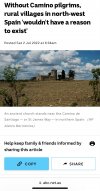Australia's national broadcaster, ABC, has this on its website. A good factual read.
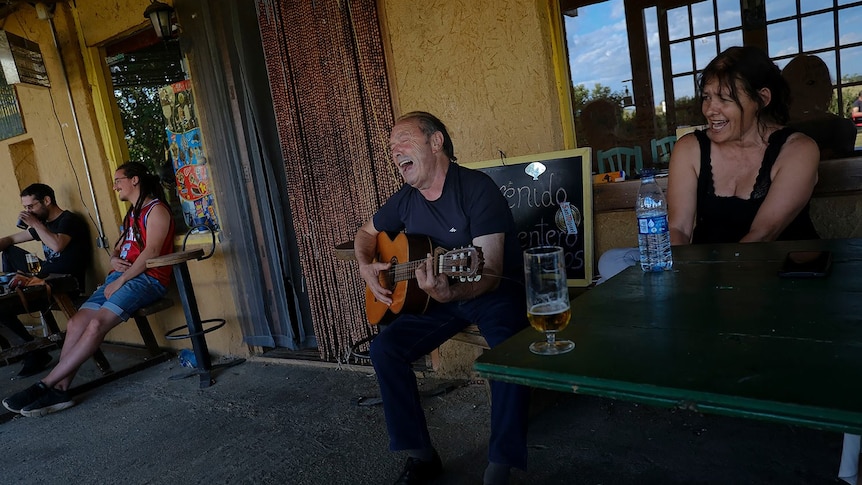
 www.abc.net.au
www.abc.net.au
Amid the vast grain fields of Spain, a medieval church stands guard over the handful of mudbrick homes where about 50 people live — and twice as many travellers along the Camino de Santiago will spend the night this summer.
In north-west Spain, Terradillos de los Templarios — and dozens of villages like it — were built to host medieval pilgrims walking the 800-kilometre route across the country to the Apostle James's tomb in Santiago de Compostela.
"This is life for the villages," Ms Quintana said. "In winter, when no pilgrims come through, you could walk through the village 200 times and see nobody."
In this small settlement — which was named after a medieval knightly order that protected protect pilgrims — the return of Camino travellers is helping to restore the livelihood and vitality of villages that were steadily losing jobs, population and their social fabric.
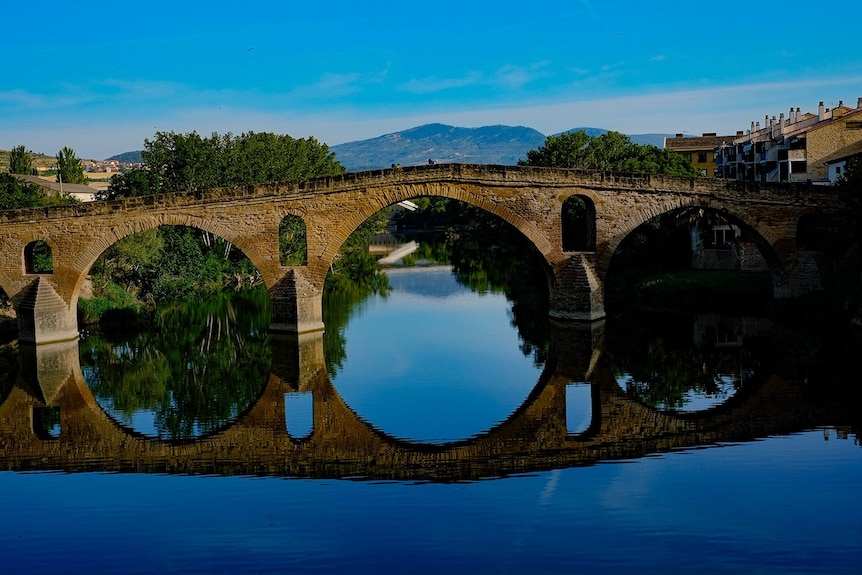
Pilgrims cross a bridge during one stage of the Camino de Santiago. (AP: Alvaro Barrientos)
Raúl Castillo patrols Spain's roads and villages as an agent with the Guardia Civil law enforcement agency.
"If it weren't for the Camino, there wouldn't even be a cafe open," he said.
"And the bar is where people meet.
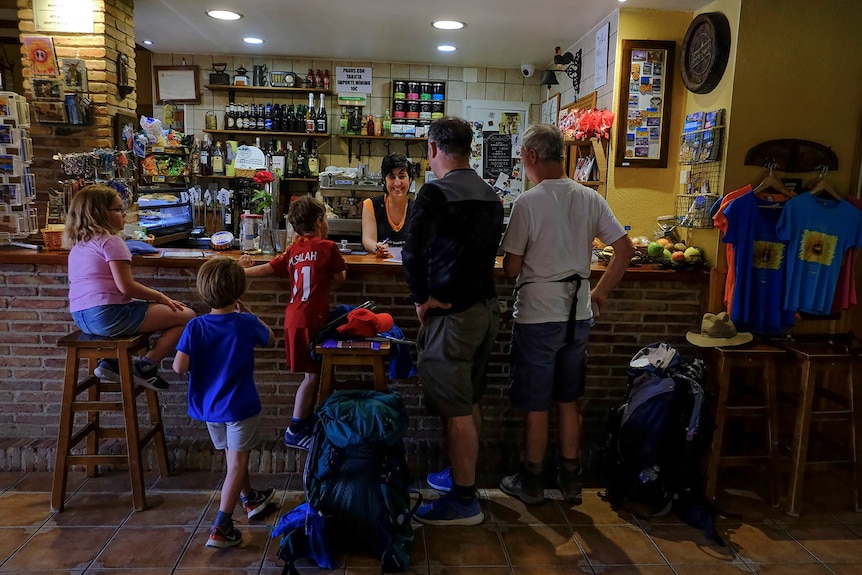
Raúl Castillo says Camino pilgrims often meet at the bar. (AP: Alvaro Barrientos)
From the Pyrenees Mountains at Spain's border with France, across hundreds of kilometres of sun-roasted plains to the mist-covered hills of Galicia and down to the Atlantic Ocean, once-booming towns of farmers and ranchers started haemorrhaging their populations in recent decades.
Mechanisation drastically reduced the need for farm labourers. As young people moved away, shops and cafes closed.
Often, so did the grand churches that were full of priceless artwork, the heritage of the medieval and Renaissance artists brought in by prospering town burghers.
However, starting in the 1990s, the Camino regained international popularity, with tens of thousands of visitors hiking and biking it year-round.
After a serious dip amid the COVID-19 pandemic, things are now looking up, with more than 25,000 visitors in May alone on the most traditional route, the French Way.
Julia Pavón is a historian at the University of Navarra in Pamplona, the Camino's first large city.
With daily visitors outnumbering residents tenfold in the tiniest of hamlets, their impact is huge.
Óscar Tardajos was born on a farm along the Camino.
For 33 years, he's managed a hotel and restaurant in Castrojeriz, a hillside village of stone buildings that was a centre of the wool trade centuries ago, when its half-dozen churches were built.
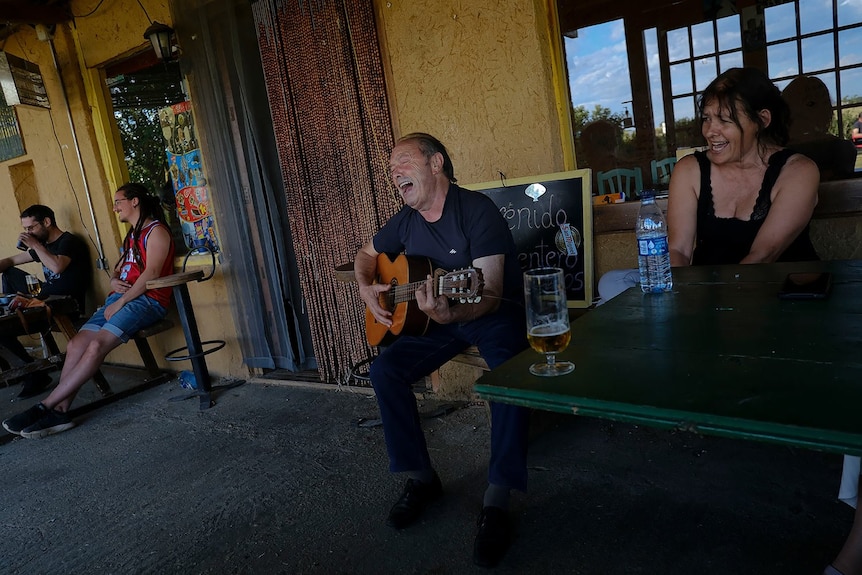
Professor Melchor Fernández says the pilgrims help boost the local economy. (AP: Alvaro Barrientos)
"It has put the brakes on depopulation which is 30% higher in Galician villages off the Camino," Professor Fernández said.
While most pilgrims spend only around 50 euros ($76 AUD) a day, it stays local.
"The bread in the pilgrim's sandwich is not Bimbo," he said, referring to the multinational company.
Aside from pilgrims, the main customers of these shops are older residents of the villages, where few younger adults live.
Lourdes González — a Paraguayan who for 10 years has owned the cafe in Redecilla del Camino — said it had become somewhat of a spectacle.
"In the summer, the grandmas sit down along the Camino to watch the pilgrims go by," Ms González said.
It has become more common for the signature yellow arrows to lead to bars or to foot massage businesses instead of the Camino.
Recently, in the town of Tardajos, Esteban Velasco, a retired shepherd, stood at a crossroads pointing the correct route to pilgrims.
Jesús Aguirre is president of the Association of Friends of the Camino de Santiago in Burgos province.
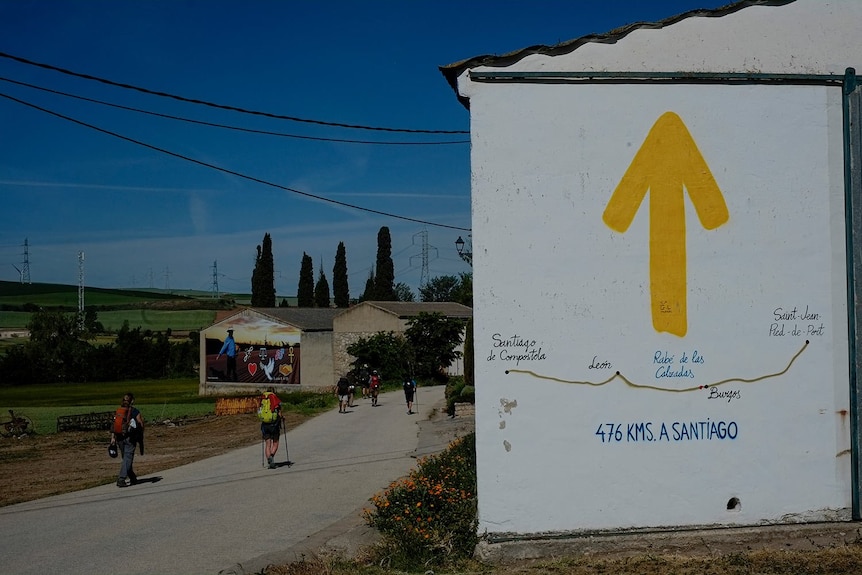
Lourdes González is worried about commercialisation on the popular route. (AP: Alvaro Barrientos)
"One can do it for different reasons, but you keep imbuing yourself with something else."
For many, that is a spiritual or religious quest.
The incentive to keep churches open for pilgrims revitalises parishes as well in a rapidly secularising Spain.
The 900-year-old church of Santa María in Los Arcos is one of the Camino villages' most magnificent, with a soaring belltower and intricately sculpted altarpiece.
Reverend Andrés Lacarra said pilgrims often double the numbers attending weekday masses.
In Hontanas, a cluster of stone houses that appear suddenly in a dip after a trek through the wide-open plains of Castilla, there's only Sunday Mass, which is often the case where one priest covers multiple parishes.
However, this week, the church bells tolled rapturously — and Father Jihwan Cho, a priest from Toronto on his second pilgrimage, was getting ready to celebrate the Eucharist.
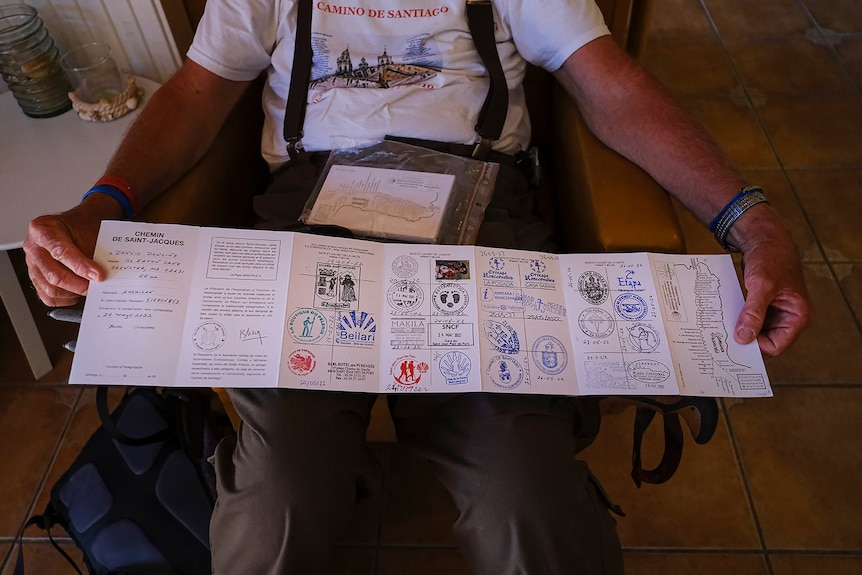
A US traveller shows his Saint James passport during a stage of Camino de Santiago. (AP: Alvaro Barrientos)
International pilgrims such as Father Cho are making some towns increasingly cosmopolitan.
In Sahagún, the English teacher instructs Nuria Quintana's daughter and her classmates to shadow pilgrims and practise their language.
César Acero — who opened a hostel and restaurant in the tiny Calzadilla de la Cueza in 1990 — said: "People have become more sociable."
Loly Valcárcel — who owns a pizzeria in Sarria — said that, when she was a young girl, she "never saw all of the nationalities" that you see now.
Hers is one of the busiest towns on the Camino because it's just past the distance needed to earn a completion "certificate" in Santiago.
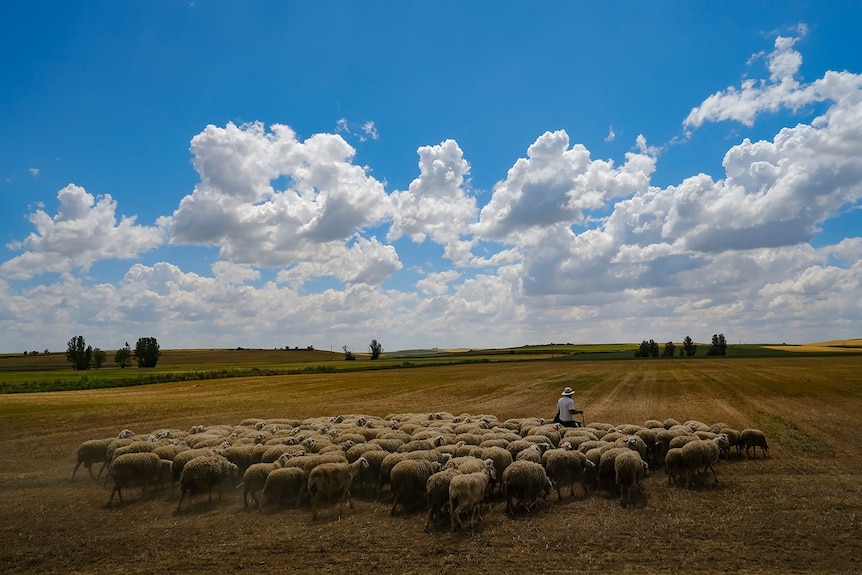
Mechanisation drastically reduced the need for farm labourers in recent decades.(AP: Alvaro Barrientos)
Far fewer pilgrims take the ancient Roman road through Calzadilla de los Hermanillos where, as a child, Gemma Herreros helped feed the sheep that her family tended for generations.
Ms Herreros runs a bed-and-breakfast with her Cuban husband, a former pilgrim, near the town's open-air museum portraying the history of the ancient road.
She hopes the village will continue to thrive — but without losing the "absolute freedom and solidarity" of her childhood entirely.
In Hornillos del Camino, a one-street village of honey-coloured stone houses, Mari Carmen Rodríguez shares similar hopes.
A handful of pilgrims came by when she was little.
Now, "the quantity of people almost makes you afraid to go into the street", she said as she stepped out from her restaurant to buy fish from a truck — a common fill-in for grocery stores in many of the villages.
Camino pilgrims revitalise rural Spain’s emptying villages
In north-west Spain, Terradillos de los Templarios — and dozens of villages like it — were built to host medieval pilgrims walking the 800-kilometer route across the country to the Apostle James' tomb in Santiago de Compostela. Today's pilgrims are keeping it alive.
Amid the vast grain fields of Spain, a medieval church stands guard over the handful of mudbrick homes where about 50 people live — and twice as many travellers along the Camino de Santiago will spend the night this summer.
In north-west Spain, Terradillos de los Templarios — and dozens of villages like it — were built to host medieval pilgrims walking the 800-kilometre route across the country to the Apostle James's tomb in Santiago de Compostela.
Villages empty without pilgrims
Nuria Quintana, who manages one of Terradillos' two pilgrim hostels, said today's Camino travellers are saving them from disappearing."This is life for the villages," Ms Quintana said. "In winter, when no pilgrims come through, you could walk through the village 200 times and see nobody."
In this small settlement — which was named after a medieval knightly order that protected protect pilgrims — the return of Camino travellers is helping to restore the livelihood and vitality of villages that were steadily losing jobs, population and their social fabric.
Pilgrims cross a bridge during one stage of the Camino de Santiago. (AP: Alvaro Barrientos)
Raúl Castillo patrols Spain's roads and villages as an agent with the Guardia Civil law enforcement agency.
"If it weren't for the Camino, there wouldn't even be a cafe open," he said.
"And the bar is where people meet.
"The villages next door, off the Camino — they make you cry. Homes falling in, the grass sprouting on the sidewalks up to here," he gestured forlornly.
Raúl Castillo says Camino pilgrims often meet at the bar. (AP: Alvaro Barrientos)
From the Pyrenees Mountains at Spain's border with France, across hundreds of kilometres of sun-roasted plains to the mist-covered hills of Galicia and down to the Atlantic Ocean, once-booming towns of farmers and ranchers started haemorrhaging their populations in recent decades.
Mechanisation drastically reduced the need for farm labourers. As young people moved away, shops and cafes closed.
Often, so did the grand churches that were full of priceless artwork, the heritage of the medieval and Renaissance artists brought in by prospering town burghers.
However, starting in the 1990s, the Camino regained international popularity, with tens of thousands of visitors hiking and biking it year-round.
After a serious dip amid the COVID-19 pandemic, things are now looking up, with more than 25,000 visitors in May alone on the most traditional route, the French Way.
Julia Pavón is a historian at the University of Navarra in Pamplona, the Camino's first large city.
With daily visitors outnumbering residents tenfold in the tiniest of hamlets, their impact is huge.
Óscar Tardajos was born on a farm along the Camino.
For 33 years, he's managed a hotel and restaurant in Castrojeriz, a hillside village of stone buildings that was a centre of the wool trade centuries ago, when its half-dozen churches were built.
"Now all that works [in town] is the hospitality industry," he said.
Professor Melchor Fernández says the pilgrims help boost the local economy. (AP: Alvaro Barrientos)
Pilgrims shop locally
Melchor Fernández — professor of economics at the University of Santiago de Compostela — said the Camino help create jobs and maintain the cultural heritage of the area."It has put the brakes on depopulation which is 30% higher in Galician villages off the Camino," Professor Fernández said.
While most pilgrims spend only around 50 euros ($76 AUD) a day, it stays local.
"The bread in the pilgrim's sandwich is not Bimbo," he said, referring to the multinational company.
According to baker Conchi Sagardía from Cirauqui, a hilltop village in Navarra, its only bakery survived because dozens of pilgrims stop by it daily."It's from the bakery next door."
Aside from pilgrims, the main customers of these shops are older residents of the villages, where few younger adults live.
Lourdes González — a Paraguayan who for 10 years has owned the cafe in Redecilla del Camino — said it had become somewhat of a spectacle.
"In the summer, the grandmas sit down along the Camino to watch the pilgrims go by," Ms González said.
Commercialisation concerns locals
Her concern — shared widely along the route — is how to keep that unique pilgrim spirit alive as the Camino's popularity leads to increased commercialisation.It has become more common for the signature yellow arrows to lead to bars or to foot massage businesses instead of the Camino.
Recently, in the town of Tardajos, Esteban Velasco, a retired shepherd, stood at a crossroads pointing the correct route to pilgrims.
Jesús Aguirre is president of the Association of Friends of the Camino de Santiago in Burgos province.
"The Camino wouldn't have a reason to exist without pilgrimage," he said.
Lourdes González is worried about commercialisation on the popular route. (AP: Alvaro Barrientos)
"One can do it for different reasons, but you keep imbuing yourself with something else."
For many, that is a spiritual or religious quest.
The incentive to keep churches open for pilgrims revitalises parishes as well in a rapidly secularising Spain.
The 900-year-old church of Santa María in Los Arcos is one of the Camino villages' most magnificent, with a soaring belltower and intricately sculpted altarpiece.
Reverend Andrés Lacarra said pilgrims often double the numbers attending weekday masses.
In Hontanas, a cluster of stone houses that appear suddenly in a dip after a trek through the wide-open plains of Castilla, there's only Sunday Mass, which is often the case where one priest covers multiple parishes.
However, this week, the church bells tolled rapturously — and Father Jihwan Cho, a priest from Toronto on his second pilgrimage, was getting ready to celebrate the Eucharist.
"The fact that I was able to celebrate mass made me really happy," he said.
A US traveller shows his Saint James passport during a stage of Camino de Santiago. (AP: Alvaro Barrientos)
International pilgrims such as Father Cho are making some towns increasingly cosmopolitan.
In Sahagún, the English teacher instructs Nuria Quintana's daughter and her classmates to shadow pilgrims and practise their language.
César Acero — who opened a hostel and restaurant in the tiny Calzadilla de la Cueza in 1990 — said: "People have become more sociable."
Loly Valcárcel — who owns a pizzeria in Sarria — said that, when she was a young girl, she "never saw all of the nationalities" that you see now.
Hers is one of the busiest towns on the Camino because it's just past the distance needed to earn a completion "certificate" in Santiago.
Mechanisation drastically reduced the need for farm labourers in recent decades.(AP: Alvaro Barrientos)
Far fewer pilgrims take the ancient Roman road through Calzadilla de los Hermanillos where, as a child, Gemma Herreros helped feed the sheep that her family tended for generations.
Ms Herreros runs a bed-and-breakfast with her Cuban husband, a former pilgrim, near the town's open-air museum portraying the history of the ancient road.
She hopes the village will continue to thrive — but without losing the "absolute freedom and solidarity" of her childhood entirely.
In Hornillos del Camino, a one-street village of honey-coloured stone houses, Mari Carmen Rodríguez shares similar hopes.
A handful of pilgrims came by when she was little.
Now, "the quantity of people almost makes you afraid to go into the street", she said as she stepped out from her restaurant to buy fish from a truck — a common fill-in for grocery stores in many of the villages.
"Without the Camino, we would go right back to disappearing," she added.









